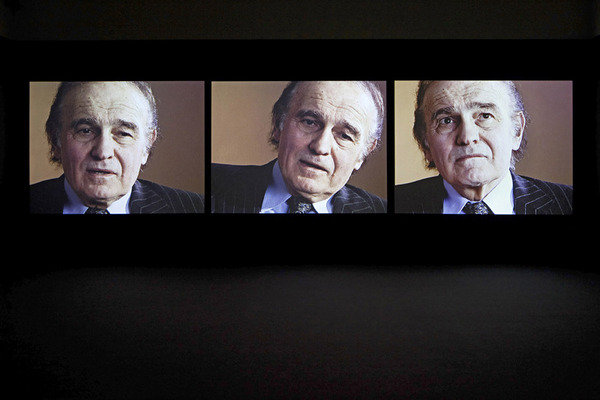Two exhibitions
dal 5/3/2014 al 11/4/2014
Segnalato da
Esther Shalev-Gerz
Jean-Sebastien Vague
Jade Barrette
Sophie Rondeau
Annette Hurtig
Charo Neville
5/3/2014
Two exhibitions
Galerie de l'Uqam, Montreal
Esther Shalev-Gerz is recognized for her investigations into the nature of democracy, citizenship, cultural memory and the politics of the public space. Since 2008, Jean-Sebastien Vague has experimented with notions of identity through their performance strategies, which draw on lived experience in order to question the relationships between individualism and conformity.

Esther Shalev-Gerz. La mémoire en mouvement
Curators: Annette Hurtig and Charo Neville
The Galerie de l'UQAM presents Esther Shalev-Gerz. La mémoire en mouvement, the third stop of the artist's first travelling Canadian solo show. Esther Shalev-Gerz is recognized internationally for her investigations into the nature of democracy, citizenship, cultural memory and the politics of the public space. Her work has inspired the contemplation of prominent aesthetic philosophers Georges Didi-Huberman and Jacques Rancière.
The exhibition is organized and circulated by the Kamloops Art Gallery (Kamloops, British Colombia) and curated by Annette Hurtig and Charo Neville. Following its run in Kamloops and at the Morris and Helen Belkin Art Gallery (UBC) in Vancouver, the exhibition will open at the Galerie de l'UQAM with two additional major installations by the artist.
La mémoire en mouvement
By employing a continual dialogue with people sharing their individual and collective experiences, the installations and public art of Esther Shalev-Gerz revisit the traditional concept of portraiture and contribute to contemporary discourse on issues of representation. The artist's work is a sustained investigation into the transitional nature of time and space correlative to the transformation of identities, places and histories. In all her projects, she also queries our understanding of the significance and social function of art.
Most of her works, by their very configuration, create a passage between past and present, confronting onlookers with their own story viewed through the prism of language, culture and history. For example, her work White-Out (2002), which presents the fate of a Sami woman living in Sweden – where even in the 1970s, the Sami, their language, their culture and their songs were not respected or accepted – suggests parallels with the plight of First Nations in North America. In the work D'eux (2009), the artist creates an implied dialogue between renowned French philosopher Jacques Rancière and a young Lebanese philosopher, Rola Younes, about their respective experiences of the renewal and enrichment of their perceptions and their relationship to the world. Younes speaks of her passion for languages while Rancière reads aloud an extract from his book, The Emancipated Spectator, in which he describes a breakthrough in his thinking that led him to "reformulate the relationship between seeing, doing and talking" and in which he comments on the function of contemporary art.
In her art, Esther Shalev-Gerz continually unravels aspects of identity related to temporal constructs of history and memory. She questions the way we understand our place in the world and presents an exchange of ideas that emerge from communication situations created through the use of video, photography, sculpture and installation.
About the artist
Esther Shalev-Gerz was born in Vilnius, Lithuania, grew up in Israel and has lived in Paris since 1984. She has been a professor at the Valand School of Fine Arts, University of Gothenburg, Sweden, since 2003. In 2010, her work was the subject of a major exhibition at the Jeu de Paume in Paris, and at the Musée Cantonal des Beaux-Arts in Lausanne, Switzerland in 2012. Since 1983, she has realized a number of public art commissions and installations focusing on questions of identity and memory (in Israel, Germany, France, the United Kingdom, Sweden and Switzerland). Esther Shalev-Gerz is the artist on a team selected as one of six finalists for the National Holocaust Monument to be erected in Ottawa.
www.shalev-gerz.net
Artist's talk
Wednesday, March 5 at 12:40 p.m., Room R-M120
The artist will deliver a lecture as part of the Intervenants Culturels Internationaux (ICI) program organized by UQAM's School of Visual and Media Arts.
Pavillon des Sciences de la Gestion, UQAM, 315 Saint Catherine Street East
Support provided by:
Canadian Heritage
Canada Council for the Arts
Service de Coopération et d'Action Culturelle du Consulat général de France à Québec
-----
Jean-Sébastien Vague. À la hauteur
Graduating Master's students in visual and media arts, UQAM
Jean-Sébastien Vague is the name that the duo Jade Barrette and Sophie Rondeau have adopted for their performance practice. Since 2008, this duo has experimented with notions of identity through their performance strategies, which draw on lived experience in order to question the relationships between individualism and conformity. The exhibition À la hauteur will present a process-based work that uses social codes related to notions of self-image in order to challenge the identity models put forth by popular culture and dominant values
Image: Esther Shalev-Gerz, Entre l'écoute et la parole : Derniers témoins. Auschwitz 1945-2005, 2005, video triptych (detail).
Opening: Thursday, March 6, 5:30 pm.



